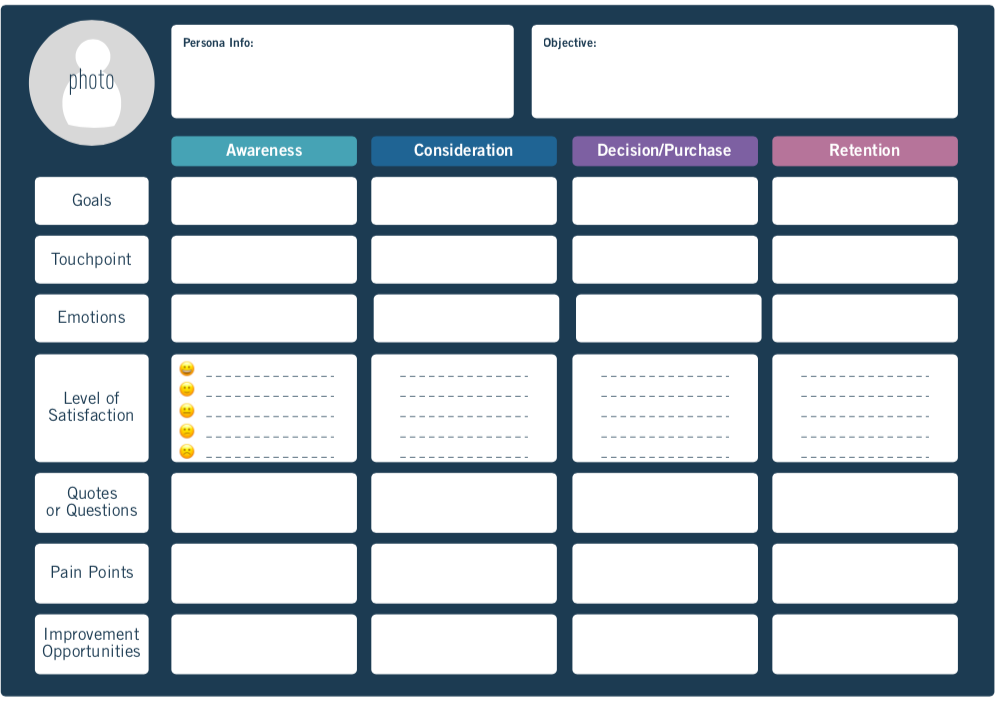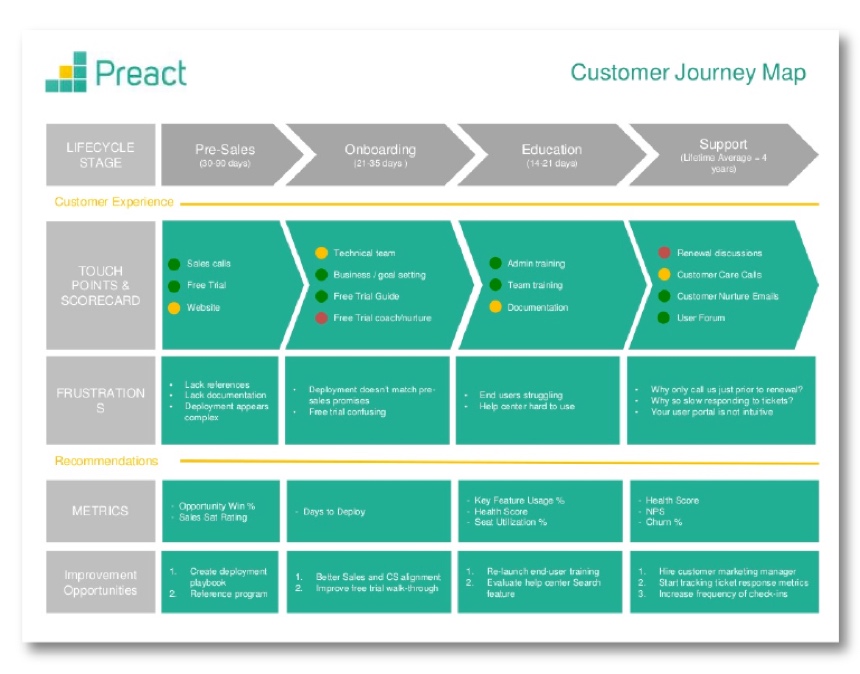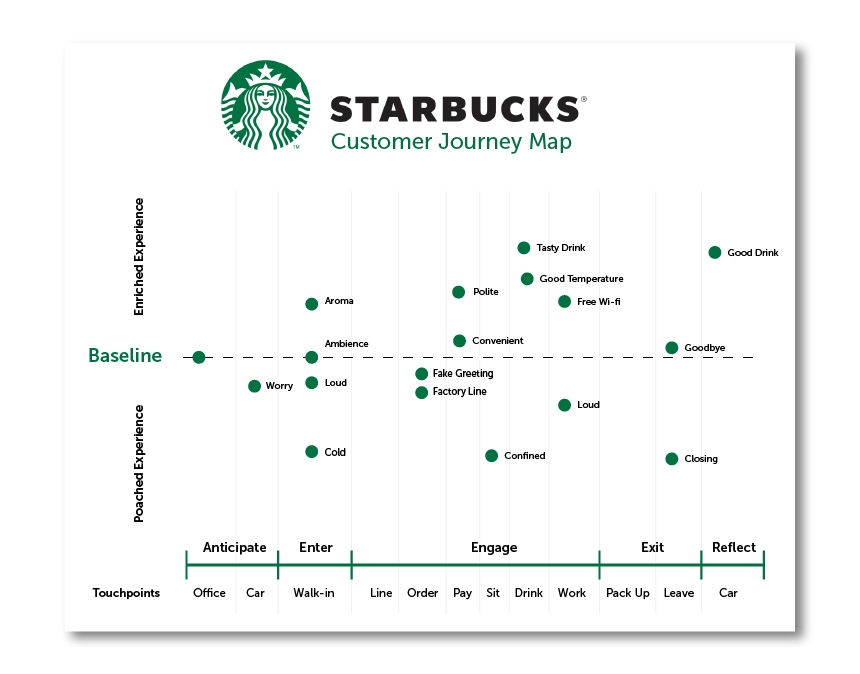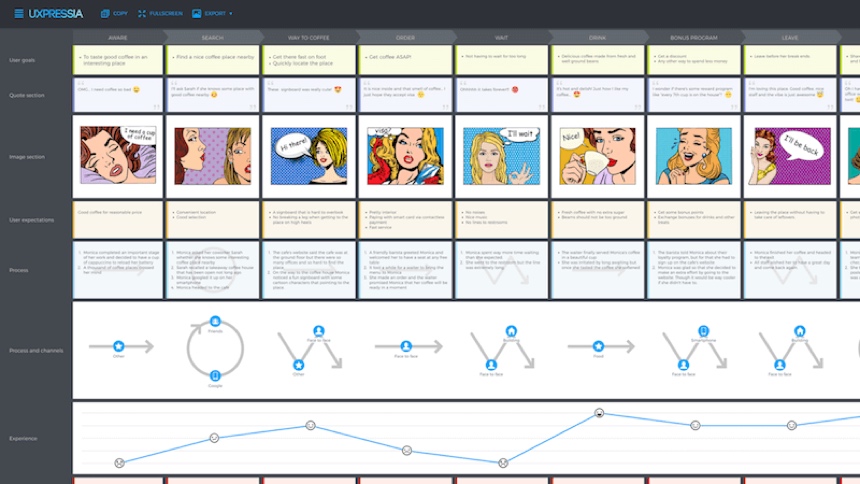A customer journey map is an excellent way to visualize how your users navigate your user experience. But what is a customer journey map, exactly? Let’s find out.
Customer experience (CX) has become quite a hot topic in the brand and product design field. While it’s still important to turn out top-notch products for a fair price, consumers are beginning to put more value in their overall experience with a company rather than how high quality their products are. This means forming meaningful long-term relationships with customers through thoughtful and smooth customer experiences.
Recent research conducted by Forrester, a well-known consulting and analytics firm, shows that customers will spend more money for a quality lifetime relationship with an organization rather than just an impressive product. Organizations that have a solid grasp on who their customers are and what they expect to achieve when interacting with the business, are more likely to grow their bottom line and reach company goals. One of the best ways to do this is to create a customer journey map.
But what is a customer journey and why should you map it out? We’ll answer those questions and more in this informative guide. Here’s what you can expect to learn:
- What is a customer journey?
- What is a customer journey map?
- How are customer journey maps used?
- Why are customer journey maps important?
- Key takeaways
Ready to learn all about customer journey maps? Let’s get started.
1. What is a customer journey?
A customer journey is the experience an established or prospective customer has with your company when trying to accomplish a certain goal. The customer journey takes into account every point of contact a customer has with a business, not just their interaction with a single product. For instance, say someone wants to find a way to learn French language quickly. Their customer journey would include their realization of the problem or goal, researching about the different solutions available to them, deciding on a product, using it, and discontinuing its use. While the product-level interaction is an important step, the customer journey takes into account how the product was marketed to the customer, customer service and support experiences, the purchasing experience, all the way to the discontinuation of use.
2. What is a customer journey map?
Customers usually have a certain goal they would like to achieve when dealing with an organization or business. A journey map gives a visual depiction of the steps it takes for them to achieve that goal and how they felt about it along the way. Using journey maps allow businesses to take a walk in their customer’s shoes and accurately experience their brand as their users would. Often this helps identify gaps or pain points in the customers experience that the organization can then address and remedy.
A customer journey map can be made with pencil and paper, sticky notes on a white board, or displayed in an Excel spreadsheet. Some businesses will even incorporate meaningful graphics into their maps to help better visualize the customer journey. These maps may focus on a certain aspect of a customer journey like service and support or they may have a broader scope and look at their customer’s daily experience.
Here are examples of some different maps and templates:
CareerFoundry: Customer journey map template

CareerFoundry’s downloadable journey map template. You can also follow this 7-step guide to build your first customer journey map.
Hubspot
Hubspot’s This A Day In the Life template map via HubSpot.com focuses on consumer’s needs throughout the day.
Preact
This Preact map is a good example of a more traditional map.

Starbucks
This Starbucks customer journey map is very linear and prioritizes the customer timeline.

UXPressia
This map from UXPressia uses meaningful and memorable graphics to display the customer journey.

3. How are customer journey maps used?
Now that we’ve explained what a customer journey map is, let’s look a little bit further into who uses them, when, and how.
Who uses customer journey maps?
Since customer journey maps have such a large scope, their use spans a variety of professional titles. CEOs, company managers, UX/UI designers, and copywriters can all gain unique insight from customer journey maps. Designers may use them to understand where the user has come from before using the product and where they will go next while a company manager might be more interested in seeing how customer’s approach and move through the sales process.
When are customer journey maps created and used?
To make the most out of a customer journey map, they should constantly be being referenced and updated as a company and their audience evolves. However, the earliest you’ll see a customer journey map in use is usually after a business starts to have a solid grasp on who their customers are and what sort of steps they take when trying to achieve their goal. Customer journey maps are regularly revisited as a company grows.
How are customer journey maps used?
So, once you’ve created a customer journey map, you may be wondering how best to use it. The main objective when creating a customer journey map is to keep the customer and their experience in the front of everyone’s mind. Many will choose to display customer journey maps in the workspace or ensure they are easily accessible to all employees. This way, all staff members can refer to it at any point in the design process to ensure the needs of the user are constantly being considered.
Be sure to keep your map research-based and up-to-date as well. If your map does not accurately portray the customer’s experience, it will be rendered useless. The best way to validate your results is by showing your map to customers and receiving their feedback.
4. Why are customer journey maps important?
The practice of moving through an experience as customers do helps businesses understand who their customers are and how they feel about their brand overall. These maps help create efficient work environments to create a brand that users feel happy to interact with as a whole.
Safeguards a brand’s promise
Looking through a customer’s eyes without bias can be difficult. Customer journey maps help compare what an organization may be claiming they provide to what their patrons are actually experiencing. Often, there can be stark differences between the two that, if left unaddressed, can have negative impacts on brand trust.
Narrows down the customer base
Along with understanding what it takes for a customer to achieve a certain goal, customer journey maps can also help narrow down exactly who a business’s customers are. Understanding your patrons is crucial to making sure you’re catering your services to the right people, in the right field, in the right way. Customer journey maps give a more personalized and complete picture of who businesses need to be reaching and connecting with.
Prioritizes the customer’s needs
One of the best ways to help customers succeed is to identify where their roadblocks may be and how to remove them. The visual nature of a customer journey map makes it easy to see what a customer’s pain points are and what can be done to move them along their journey with ease. Because journey maps look at the life-long relationship between customer and company, they give designers and businesses greater context when learning how to solve their customers’ needs.
Improves company communication
It can be common for consumers to express difficulty navigating between different divisions of a company. They may experience a great sales process but have trouble contacting support. Design tools that help all the different departments of an organization communicate effectively are almost invaluable. Customer journey maps help all sections of a company understand how their consumers move and what their goals are. This knowledge helps each department understand where the customer is coming from and gives them the ability to assist the customer along their journey by providing next steps.
5. Key takeaways
Understanding consumers through the creation of a customer journey map can help identify what customers need to have a positive overall experience with a brand.
While customer journey maps can provide deep insight into their customers’ experience, companies should be sure to combine this knowledge gained with other user research tools like empathy maps, user personas, and storyboarding. Used together, these design aids can help all aspects of a business create stellar experiences and products for their key audiences and consumers.
To learn more about how to craft great user/customer experiences, check out these articles:
